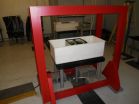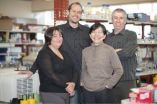(Press-News.org) EDITOR'S PICK: Preserving nerve cells in motor neuron disease
A team of researchers, led by Scott Oakes, at the University of California, San Francisco, has identified a way to prevent symptom onset, weight loss, and paralysis and extend survival in a mouse model of amyotrophic lateral sclerosis (ALS; also known as Lou Gehrig's disease), providing a new avenue of research for the development of therapeutics for ALS and other motor neuron diseases.
ALS and other motor neuron diseases are neurological disorders that selectively affect nerve cells that control voluntary muscle activities such as speaking, walking, breathing, swallowing, and general movement of the body. A key feature of these diseases is that the affected nerve cells (which are known as motor neurons) die by a process known as apoptosis. Determining whether this death contributes to disease or occurs after the nerves have stopped functioning is important to establishing whether blocking apoptosis would have therapeutic benefit. In the study, genetically eliminating activation of the mitochondrial apoptotic pathway in a mouse model of ALS was shown to preserve motor neuron viability and function, thereby preventing symptom onset, weight loss, and paralysis and extending survival. The authors therefore suggest that inhibiting activation of the mitochondrial apoptotic pathway might provide a way to preserve motor neurons in individuals with ALS and other motor neuron diseases.
TITLE: Blocking the mitochondrial apoptotic pathway preserves motor neuron viability and function in a mouse model of amyotrophic lateral sclerosis
AUTHOR CONTACT:
Scott A. Oakes
University of California, San Francisco, San Francisco, California, USA.
Phone: 415.476.1777; Fax: 415.514.3165; E-mail: scott.oakes@ucsf.edu.
View this article at: http://www.jci.org/articles/view/42986?key=b51352dad375af860586
HEMATOLOGY: Knocking down obstacles to leukemia therapy
One approach being developed for the treatment of cancer is the infusion of immune cells known as CD8+ T cells into the patient. The transferred CD8+ T cells are specially expanded in culture and selected for being able to target the cancer cells. Although this approach has been effective in some patients, several issues, including poor in vivo survival and function of the transferred cells, have limited further clinical use. However, a team of researchers, led by Philip Greenberg, at the University of Washington, Seattle, has identified a potential way to improve the efficacy of this approach by modeling the therapy in mice with leukemia.
The team found that eliminating the protein Cbl-b in the CD8+ T cells to be transferred increased their therapeutic effects in a mouse model of leukemia. The enhanced therapeutic effects of the transferred CD8+ T cells lacking Cbl-b were a result of their improved survival and enhanced functionality. As knocking down Cbl-b expression in human CD8+ T cell clones had similar in vitro effects, the authors suggest that reducing Cbl-b expression in tumor-specific CD8+ T cells destined for adoptive transfer into patients with cancer might improve their therapeutic efficacy.
TITLE: Abrogating Cbl-b in effector CD8+ T cells improves the efficacy of adoptive therapy of leukemia in mice
AUTHOR CONTACT:
Philip D. Greenberg
Department of Immunology, University of Washington, Seattle, Washington, USA.
Phone: 206.543.8306; Fax: 206.221.2796; E-mail: pgreen@u.washington.edu.
View this article at: http://www.jci.org/articles/view/41991?key=e1ea14c6fcfdb9ddc78c
IMMUNOLOGY: Expanding immune suppressors in vivo
Immune cells known as Tregs have a key role in preventing the immune system from damaging our own bodies. Identifying ways to expand these cells for the treatment of individuals with autoimmune conditions and recipients of transplanted organs is an area of intensive research. Now, Eckhard Podack and colleagues, at the University of Miami Miller School of Medicine, Miami, have determined that stimulating mouse Tregs in vivo via a protein on their cell surface known as TNFRSF25 induces their rapid expansion. Importantly, expanding Tregs in vivo provided protection from subsequent induction of allergic lung inflammation, a mouse model of asthma. The authors therefore believe that their data have may have important implications for the treatment of autoimmune diseases and transplantation as well as chronic infection and cancer, situations in which excessive numbers of Tregs are detrimental.
TITLE: Therapeutic Treg expansion in mice by TNFRSF25 prevents allergic lung inflammation
AUTHOR CONTACT:
Eckhard R. Podack
University of Miami Miller School of Medicine, Miami, Florida, USA.
Phone: 305.243.3033; Fax: 305.243.5522; E-mail: epodack@med.miami.edu.
View this article at: http://www.jci.org/articles/view/42933?key=0f49dca725c6485edef8
DEVELOPMENT: Knocking eye development for Six(3)
The impaired vision and eventual blindness caused by various diseases of the eye are a result of degeneration of the retina — the light-sensitive tissue that lines the inner surface of the eye. It has been suggested that stem cell–based cell replacement therapies might one day be used to treat these conditions. If this is to come to pass, however, we need to better understand normal development of the retina. In this context, a team of researchers, led by Guillermo Oliver, at St. Jude Children's Research Hospital, Memphis, has now identified the protein Six3 as crucial for formation of the mouse neural retina — the portion of the retina that absorbs light, converting the information it provides to something that can be understood by the brain. Mechanistically, Six3 was shown to exert this effect by repressing expression of the Wnt8b gene. The authors hope that their data might help future development of approaches to control the therapeutic generation of neural retina cells.
TITLE: Neuroretina specification in mouse embryos requires Six3-mediated suppression of Wnt8b in the anterior neural plate
AUTHOR CONTACT:
Guillermo Oliver
St. Jude Children's Research Hospital, Memphis, Tennessee, USA.
Phone: 901.595.2697; Fax: 901.595.6035; E-mail: guillermo.oliver@stjude.org.
View this article at: http://www.jci.org/articles/view/43219?key=09e6c3c76a9640bf3908
DEVELOPMENT: A Notch(1) in the road to understanding heart valve formation
The most commonly diagnosed congenital heart defects are malformations of the heart valves. Increased understanding of the molecular mechanisms underlying valve formation in the embryo should provide new avenues of research into the origin of cardiac valve defects. New insight into this has now been provided by a team of researchers, led by José Luis de la Pompa, at Centro Nacional de Investigaciones Cardiovasculares, Spain, that studied embryonic heart valve formation in mice.
In the study, the authors generated multiple lines of evidence to support the conclusion that integration of Notch1 signals in endocardial cells and Bmp2 signals in myocardial cells is critical to embryonic heart valve formation in mice. These data suggest that both cell types involved in heart valve formation have an active role, information that provides new insight into the process because it had previously been thought that endocardial cells played a passive role only.
TITLE: Integration of a Notch-dependent mesenchymal gene program and Bmp2-driven cell invasiveness regulates murine cardiac valve formation
AUTHOR CONTACT:
José Luis de la Pompa
Centro Nacional de Investigaciones Cardiovasculares (CNIC), Madrid, Spain.
Phone: 34.91.4531334; Fax: 34.91.4531304; E-mail: jlpompa@cnic.es.
View this article at: http://www.jci.org/articles/view/42666?key=92920bf5913c6f86296b
CARDIOLOGY: Signaling pathway has distinct effects in two heart cell types
Previous work in animals has suggested that the protein Mst1 might be a target for the treatment of heart failure. But new research in mice, led by Junichi Sadoshima, at the University of Medicine and Dentistry of New Jersey, Newark, now indicates that Mst1 has distinct effects in different cells in the heart such that targeting this protein in all heart cells could be detrimental.
In the study, the protein Rassf1A was found to be an activator of Mst1 in the mouse heart. Consistent with previous work, the Rassf1A/Mst1 pathway promoted heart dysfunction when activated in heart muscle cells. However, when activated in support cells in the heart known as fibroblasts, it provided protection from pressure overload, a model of high blood pressure–induced heart failure. The authors therefore conclude that the consequence of activating the Rassf1A/Mst1 pathway during pressure overload is cell type dependent in the heart and that any therapy targeting this pathway would have to be cell specific.
TITLE: Proapoptotic Rassf1A/Mst1 signaling in cardiac fibroblasts is protective against pressure overload in mice
AUTHOR CONTACT:
Junichi Sadoshima
New Jersey Medical School, University of Medicine and Dentistry of New Jersey, Newark, New Jersey, USA.
Phone: 973.972.8619; Fax: 973.972.7489; E-mail: sadoshju@umdnj.edu.
View this article at: http://www.jci.org/articles/view/43569?key=343775410582601326d9
CARDIOLOGY: A mitochondrial pore balances energy generation and consumption
New research in mice, led by Jeffery Molkentin, at the University of Cincinnati, Cincinnati, has identified a physiologic function for the mitochondrial permeability transition pore (MPTP), a protein complex with no previously known physiologic function.
Mitochondria are cellular compartments whose main function is to generate energy for the cell. In the study, mice lacking the protein cyclophilin D, which modulates opening of the MPTP, were found to develop more severe heart dysfunction in response to pressure overload, a model of high blood pressure–induced heart failure, than normal mice. Mechanistically, the heart dysfunction was associated with altered MPTP-mediated efflux of calcium ions (Ca2+), with Ca2+ accumulating inside mitochondria. The effects of this lead the authors to suggest that MPTP controls mitochondrial Ca2+ levels to match energy generation by mitochondria with the demand for energy by the cell.
TITLE: Cyclophilin D controls mitochondrial pore–dependent Ca2+ exchange, metabolic flexibility, and propensity for heart failure in mice
AUTHOR CONTACT:
Jeffery D. Molkentin
University of Cincinnati, Cincinnati Children's Hospital Medical Center, Cincinnati, Ohio, USA.
Phone: 513.636.3557; Fax: 513.636.5958;
E-mail: jeff.molkentin@cchmc.org.
View this article at: http://www.jci.org/articles/view/43171?key=9d29035e03701e652fad
VIROLOGY: Unraveling how parvovirus B19 causes disease
Parvovirus B19 causes a wide spectrum of human diseases, including fifth disease in children and pure red cell aplasia in patients with a compromised immune system. The mechanisms by which parvovirus B19 causes disease are largely unknown, as there are no cell lines in which the virus can grow and no experimental animals susceptible to infection. But now, Ning Zhi and colleagues, at the National Institutes of Health, Bethesda, have used a recently developed system for culturing parvovirus B19 to identify factors in the infected cells that are exploited by parvovirus B19 to cause disease. Specifically, parvovirus B19 modulates the expression of gene regulatory proteins known as E2Fs to cause the infected cells (human red blood cell progenitors) to stop dividing. These data provide new insight into the mechanisms by which parvovirus B19 causes disease.
TITLE: Human parvovirus B19 causes cell cycle arrest of human erythroid progenitors via deregulation of the E2F family of transcription factors
AUTHOR CONTACT:
Ning Zhi
National Heart, Lung, and Blood Institute, NIH, Bethesda, Maryland, USA.
Phone: 301.451.7137; Fax: 301.496.8396; E-mail: zhin@nhlbi.nih.gov.
View this article at: http://www.jci.org/articles/view/41805?key=bbecabf6a68ed773c1c3
###
JCI online early table of contents: Sept. 20, 2010
2010-09-20
ELSE PRESS RELEASES FROM THIS DATE:
Lightweight true random number generators a step closer
2010-09-20
The widespread use of true random number generators (TRNGs) has taken a step closer following the creation of the most lightweight designs to date by researchers at Queen's University Belfast's Institute of Electronics, Communications and Information Technology (ECIT).
Members of the Institute's cryptography research team have produced a series of circuits that are up to 50 per cent smaller than anything else currently available. Optimised for digital circuits, FPGA and ASIC, they push efficiency to the limit by using just one logic gate, one look-up table and four transistors ...
Protein may advance Parkinson's by preventing neurons from clearing debris
2010-09-20
A protein linked to Parkinson's disease may cause neurodegeneration by inhibiting autophagy—the process in which cells digest some of their contents—according to a study in the September 20 issue of the Journal of Cell Biology (www.jcb.org).
Autophagy serves to clear a variety of toxic waste from cells, including misfolded proteins and defective mitochondria. These two types of cellular trash accumulate in neurons from Parkinson's patients, suggesting that autophagy could be impaired in these cells. A commonly amassed protein in Parkinson's disease is alpha-synuclein, ...
Magnetic attraction for fish, crabs?
2010-09-20
SEATTLE – Super-sized electromagnetic coils are helping explain how aquatic life might be affected by renewable energy devices being considered for placement along America's coastal waters and in the nation's rivers.
Scientists with the Department of Energy's Pacific Northwest National Laboratory are examining whether a variety of fish and invertebrates change their behavior during and after exposure to an electromagnetic field similar to those produced by marine and hydrokinetic power devices that capture energy from ocean waves, tides, currents and rivers. Research began ...
Female fish abandoned by males to raise offspring on their own
2010-09-20
Caring for children can be a tough job, particularly if you are a female cichlid fish.
Native to the crater lakes of Nicaragua, cichlid fish look after their young by defending them against would-be predators. While male and female cichlid fish generally share parental responsibilities, research shows that this is not always the case.
Conducted by an international team of researchers that included two biologists from Monash University, and published in the journal Behavioral Ecology and Sociobiology, new research has shown that male cichlid fish have a propensity ...
Secrets of birds' sexual signals revealed
2010-09-20
Patterned feathers, previously thought to be used only for camouflage in birds, can play an important role in attracting a mate and fending off rivals, a University of Melbourne study reveals.
Ms Thanh-Lan Gluckman, co-author of the paper and Masters of Philosophy student from the Department of Zoology at the University of Melbourne, Australia, said this finding brought a new perspective to research in animal communication and evolution.
"The implication of this study is that feathers don't need to be bright and showy to be used in sexual signalling and hence this changes ...
Protein behind development of immune system sentinels identified
2010-09-20
A protein called PU.1 is essential for the development of dendritic cells, the sentinels of the immune system, Walter and Eliza Hall Institute researchers in Melbourne, Australia, have shown.
Dendritic cells (DC) are immune cells that present proteins from foreign invaders, such as viruses, to the killer T cells of the immune system, allowing a full immune response to be mounted against the invaders.
Researchers from the Immunology division have been studying dendritic cells and how different molecules regulate their development.
Dr Li Wu said one of the molecules ...
Citizen scientist
2010-09-20
We are all scientists now, thanks to SETI@home, Galaxy Zoo, The Great Sunflower Project, Folding@home and counltess other projects that allow individuals to take part in scientific research directly or indirectly. In the case of SETI@home and Folding@home one shares one's computer CPU with the researchers, whereas Galaxy Zoo is more about active involvement with the classification of stellar objects in images of the night sky, for instance.
Now, writing in the International Journal of Organisational Design and Engineering, US researchers have mapped out an approach to ...
Marine scientists unveil the mystery of life on undersea mountains
2010-09-20
They challenge the mountain ranges of the Alps, the Andes and the Himalayas in size yet surprisingly little is known about seamounts, the vast mountains hidden under the world's oceans. Now in a special issue of Marine Ecology scientists uncover the mystery of life on these submerged mountain ranges and reveal why these under studied ecosystems are under threat.
The bathymetry of our oceans is now resolved at a scale and detail unimaginable by early pioneers and recent estimates suggest that, globally, there may be up to 100,000 seamounts, yet despite best efforts less ...
Study gets measure of how best to prevent blood clots
2010-09-20
Treating hospital patients with thigh-length surgical stockings, rather than knee-high socks, can reduce life threatening blood clots, a new study suggests.
Researchers found that knee-high stockings, which are similar to flight socks, do little in stroke patients to prevent deep vein thrombosis (DVT), a life threatening form of blood clot that can travel up into the heart and lungs, .
The CLOTS (Clots in Legs Or sTockings after Stroke) study from the University of Edinburgh highlights that the clot rate in stroke patients was higher among those fitted with the shorter ...
The Amazon rainforest -- a cloud factory
2010-09-20
The forest in the Amazon Basin produces its own rain. During the wet season, aerosol particles, which serve to condensate clouds and precipitation here, mainly consist of organic material. These aerosols are released by the rainforest itself. This has been demonstrated by scientists from the Max Planck Institute for Chemistry in Mainz, who are now able to draw conclusions about the mechanisms of this ecosystem: the high content of organic material indicates that the Amazon Basin acts as a largely self-contained biogeochemical reactor during the rainy season. The results ...





